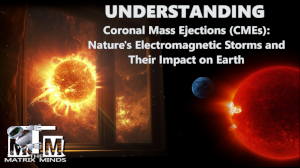 The universe is a dynamic and interconnected system, with various phenomena occurring on different scales. Among these cosmic events, Coronal Mass Ejections (CMEs) stand out as mesmerizing and potentially disruptive events that affect our planet. Let’s try to shed light on the nature of CMEs and delve into their effects on Earth.
The universe is a dynamic and interconnected system, with various phenomena occurring on different scales. Among these cosmic events, Coronal Mass Ejections (CMEs) stand out as mesmerizing and potentially disruptive events that affect our planet. Let’s try to shed light on the nature of CMEs and delve into their effects on Earth.
Understanding Coronal Mass Ejections:
Coronal Mass Ejections, often referred to as CMEs, are colossal eruptions of plasma and magnetic field from the Sun’s outer atmosphere, known as the corona. These events are characterized by the expulsion of billions of tons of charged particles, primarily electrons and protons, at speeds ranging from 20 to 3,000 kilometers per second.
Causes of CMEs:
CMEs usually originate from regions of intense magnetic activity on the Sun, such as sunspots or active regions. The magnetic fields within these regions become highly twisted and stressed, eventually leading to a sudden release of energy. This energy release propels the ejected material into space, creating a CME.
A CME comprises three distinct components: the core, the leading edge, and the trailing edge. The core consists of a dense and relatively slow-moving plasma cloud, while the leading edge is characterized by a shock wave that accelerates charged particles. The trailing edge is a region of decreased plasma density.
Once launched from the Sun, CMEs follow a trajectory determined by the Sun’s magnetic field. However, due to the Sun’s rotation, CMEs can often miss Earth or pass by with minimal impact. But when they are directed towards our planet, their effects can be significant.
Impacts of CMEs on Earth:
- Geomagnetic Storms: As a CME interacts with Earth’s magnetic field, it can cause disturbances known as geomagnetic storms. The high-speed particles carried by the CME interact with Earth’s magnetosphere, generating intense electrical currents. These currents can induce voltage surges in power grids, leading to blackouts and damage to electrical infrastructure.
- Auroras: CMEs are responsible for creating mesmerizing auroras, also known as the Northern and Southern Lights. When the charged particles from the CME collide with molecules in Earth’s atmosphere, they emit colorful light displays in polar regions.
- Radiation Hazards: CMEs pose a potential threat to astronauts and satellites. The influx of high-energy particles can damage or disrupt satellite systems, interrupting communication and navigation services. Additionally, astronauts in space may be exposed to increased levels of radiation during intense CME events.
- Impact on Technology: CMEs can interfere with various technological systems, including radio communications, GPS navigation, and satellite-based services. Transient disruptions in these systems can have far-reaching consequences, affecting transportation, financial transactions, and emergency response networks.
See the Daily, DASHBOARD here.
While CMEs can have adverse effects, scientists and engineers continuously work on developing early warning systems and protective measures. Space weather monitoring satellites and ground-based observatories enable the detection and tracking of CMEs, providing crucial information for preparedness and response.
In the future, continued research and investment in space weather forecasting can help minimize the impact of CMEs on Earth. Improved understanding of CMEs and their behavior will facilitate the development of strategies to protect critical infrastructure and ensure the safety of our technological systems.
Coronal Mass Ejections are captivating celestial events with the potential to impact our planet significantly. As we explore the nature of these electromagnetic storms, it is essential to understand their effects on Earth’s technology, infrastructure, and space-based systems. By advancing our knowledge and preparedness, we can mitigate the risks associated with CMEs and ensure a resilient response to these mesmerizing cosmic phenomena.
Our knowledge and preparedness, we can mitigate the risks associated with CMEs and ensure a resilient response to these mesmerizing cosmic phenomena.
To achieve this, ongoing research is focused on improving our understanding of CME initiation, propagation, and impact prediction. Scientists are developing sophisticated models and simulations that simulate the behavior of CMEs, allowing for better forecasting of their trajectory and intensity. By monitoring the Sun’s activity and identifying signs of CME formation, scientists can issue timely alerts and warnings to spacecraft operators, power grid operators, and other stakeholders.
International collaboration is also crucial in addressing the challenges posed by CMEs. Organizations such as the National Aeronautics and Space Administration (NASA), the European Space Agency (ESA), and other space agencies around the world work together to share data, observations, and research findings. This collaborative effort enhances our global capability to monitor space weather and improve prediction accuracy.
In addition to monitoring and prediction, efforts are underway to develop technologies and systems that can withstand the impact of CMEs. Engineers are designing spacecraft and satellites with enhanced shielding to protect sensitive electronics from the energetic particles associated with CMEs. Similarly, power grid operators are implementing measures to improve the resilience of electrical infrastructure, such as installing surge protectors and developing protocols to minimize the risk of blackouts during geomagnetic storms.
Public awareness and education play a vital role in dealing with the effects of CMEs. Informing the general public, policymakers, and industries about the potential risks and impacts of CMEs can help foster preparedness and resilience. Educational programs and resources can be developed to educate individuals about space weather, its significance, and the steps they can take to protect themselves and their technology during CME events.
Looking ahead, advancements in technology and research hold promise for better understanding and managing the impact of CMEs on Earth. As our reliance on technology continues to grow, it becomes increasingly crucial to invest in space weather research, infrastructure protection, and international collaboration. By doing so, we can minimize the disruption caused by CMEs and ensure the continued safety and functionality of our interconnected world.
Coronal Mass Ejections are captivating cosmic events that can have both awe-inspiring and disruptive effects on our planet. Through scientific research, technological advancements, international collaboration, and public awareness, we can enhance our ability to predict, mitigate, and respond to the impacts of CMEs. By doing so, we can safeguard critical infrastructure, protect technological systems, and ensure the resilience of our planet in the face of these electromagnetic storms from the Sun.



Leave a Reply
Want to join the discussion?Feel free to contribute!